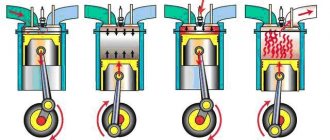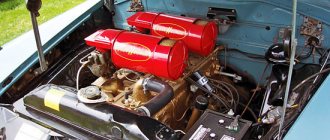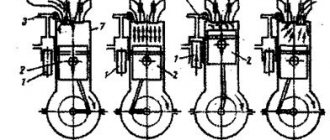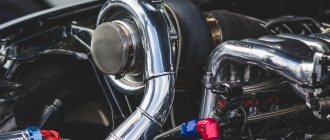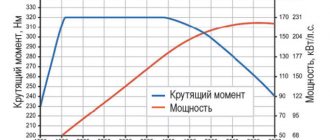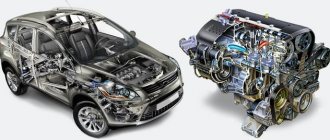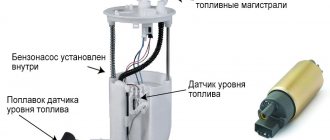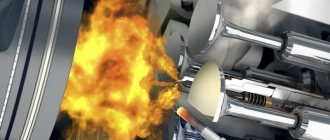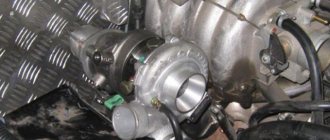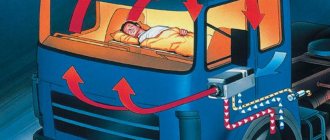Four-stroke engine, device and principle of operation
The engine operating cycle is a periodically repeating series of sequential processes occurring in each cylinder of the engine and causing the conversion of thermal energy into mechanical work.
Car engines most often operate on a four-stroke cycle, which is completed in two revolutions of the crankshaft or four strokes of the piston and consists of intake, compression, expansion and exhaust strokes. In a carburetor four-stroke engine, the operating cycle occurs as follows.
Carburetor engine duty cycle:
— Compression stroke The piston goes from BDC to TDC, compressing the working mixture.
In this case, the temperature of the mixture increases significantly. The ratio of the working volume of the cylinder at BDC to the volume of the combustion chamber at TDC is called the compression ratio. The compression ratio is a very important parameter; usually, the higher it is, the greater the fuel efficiency of the engine. However, an engine with a higher compression ratio requires higher octane fuel, which is more expensive. Expansion stroke, or power stroke Shortly before the end of the compression cycle, the air-fuel mixture is ignited by a spark from the spark plug. During the piston's journey from TDC to BDC, fuel burns, and under the influence of the heat of the burned fuel, the working mixture expands, pushing the piston. When expanding, gases perform useful work, therefore the stroke of the piston during this stroke of the crankshaft is called the power stroke. The degree to which the engine crankshaft is “underrotated” to TDC when the mixture is ignited is called the ignition timing angle. Ignition timing is necessary so that fuel combustion has time to completely end by the time the piston reaches BDC, that is, for the most efficient operation of the engine. Fuel combustion takes almost a fixed time, so to improve engine efficiency, you need to increase the ignition timing as the speed increases. In older engines, this adjustment was made by a mechanical device (centrifugal and vacuum regulator acting on a chopper). Modern engines use electronics to adjust the ignition timing.
The GIF clearly demonstrates the operation of a four-stroke engine.
— Exhaust stroke After BDC of the working cycle, the exhaust valve opens and the upward moving piston displaces the exhaust gases from the engine cylinder. When the piston reaches TDC, the exhaust valve closes and the cycle begins again.
It is almost impossible to completely clean the engine cylinders from combustion products (too little time), therefore, with the subsequent intake of a fresh combustible mixture, it moves with the residual exhaust gases and is called the working mixture.
The residual gas coefficient characterizes the degree of contamination of the fresh charge with exhaust gases and is the ratio of the mass of combustion products remaining in the cylinder to the mass of the fresh combustible mixture. For carburetor engines, the residual gas coefficient is in the range of 0.06-0.12.
In relation to the power stroke, the intake, compression and exhaust strokes are auxiliary.
Operating cycle of a diesel engine The operating cycles of a four-stroke diesel engine and a carburetor engine differ significantly in the method of mixture formation and ignition of the working mixture. The main difference is that during the intake stroke, not a combustible mixture enters the diesel cylinder, but air, which, due to the high degree of compression, is heated to a high temperature, and then finely atomized fuel is injected into it, which spontaneously ignites under the influence of high air temperature.
Third stroke - power stroke
The third stroke is the working one, starting at TDC. It is no coincidence that he is called a worker. After all, it is in this beat that the action that makes the car move occurs. At this stroke, the ignition system comes into operation. Why is this system called that? Yes, because it is responsible for igniting the fuel mixture compressed in the cylinder in the combustion chamber. It works very simply - the system spark plug gives a spark. In fairness, it is worth noting that the spark is produced at the spark plug a few degrees before the piston reaches the top point. These degrees, in a modern engine, are regulated automatically by the “brains” of the car.
After the fuel ignites, an explosion occurs - it sharply increases in volume, forcing the piston to move down. The valves in this stroke of the engine, as in the previous one, are in a closed state.
In a four-stroke diesel engine, working processes occur as follows.
The piston moves from BDC to TDC. The intake and exhaust valves are closed, as a result of which the upward moving piston compresses the air present in the cylinder. For fuel to ignite, the temperature of the compressed air must be higher than the auto-ignition temperature of the fuel.
— Expansion stroke, or power stroke As the piston approaches TDC, diesel fuel is injected into the cylinder through an injector, supplied by a high-pressure fuel pump (HPF). The injected fuel, mixing with heated air, self-ignites and the combustion process begins, characterized by a rapid increase in temperature and pressure. Under the influence of gas pressure, the piston moves from TDC to BDC. A working process is taking place.
— Exhaust stroke The piston moves from BDC to TDC and through the open exhaust valve the exhaust gases are pushed out of the cylinder. After the end of the exhaust stroke, with further rotation of the crankshaft, the working cycle is repeated in the same sequence.
This video shows the operation of a real engine. The camera is built into the cylinder of the block.
ICE duty cycle: what you need to know
If we consider the principle of operation of an internal combustion engine, the fuel in such units burns in a closed chamber (combustion chamber), into which a ready-made fuel-air mixture or air and fuel are supplied separately (diesel units and engines with direct injection).
The operation of such a motor is based on the fact that gases expand during combustion of fuel. These gases cause an increase in pressure in the cylinder, due to which the piston receives a “push”. The energy transferred to the piston is then converted into mechanical work. Let's look at the principle of engine operation, as well as duty cycles, in more detail.
So, the engine operating cycle is sequentially repeating processes that occur in the cylinders as part of the transformation of the thermal energy of the fuel into useful mechanical work. If one working cycle is completed in 2 strokes of the piston, when the crankshaft makes one revolution, such an engine is two-stroke.
Engines that are installed in cars usually operate on a four-stroke cycle (four-stroke engine). This means that the working cycle is completed in two crankshaft revolutions and four piston strokes. The operation of such an internal combustion engine can be divided into strokes: intake stroke, compression stroke, power stroke, exhaust stroke.
How does a four-stroke gasoline engine work?
To make it clearer, let's start with the fact that when the piston in the cylinder, during operation of the internal combustion engine, begins to occupy extreme positions (as close as possible or as far away as possible relative to the axis of the crankshaft), these positions are usually called TDC and BDC. TDC means top dead center whereas BDC means bottom dead center. Now let's get back to the beats.
- During the intake stroke, the engine crankshaft makes the first half of a revolution, while the piston moves from TDC to BDC. At this moment, the inlet valve is open and the outlet valve is closed. As the piston moves downward, a vacuum is formed in the cylinder, as a result of which the fuel-air mixture is “sucked” into the cylinder through the open intake valve. The working mixture consists of air and atomized fuel (in some engines only air enters during the intake stroke).
- The next step is compression. After the cylinder is filled with the fuel-air mixture, the crankshaft begins to make the second half of its revolution. At this moment, the piston begins to rise from BDC to TDC. In this case, the inlet valve is already closed. Next, the piston compresses the mixture in a hermetically sealed cylinder. The more the volume of the cylinder decreases, the more the mixture is compressed. The result of this compression is an increase in the temperature of the mixture.
- By the time the piston reaches the end of the compression stroke (almost reaches TDC), the mixture in gasoline engines is ignited from an external source (an electric spark at the spark plug). The fuel charge then burns, causing the temperature and pressure in the cylinder to rise sharply. At this moment, the piston is already moving back from TDC to bottom dead center, taking on the energy of the expanding gases.
Next, energy is transferred from the piston through the connecting rod to the crankshaft, allowing the engine crankshaft to rotate. At this time, the crankshaft makes the third half-turn, and the movement of the piston from TDC to BDC is called the working stroke of the piston.
- After the piston almost reaches BDC at the end of the stroke, the exhaust valve opens. After this, the pressure in the cylinder decreases, and the temperature also drops slightly. Then the release stroke begins. At this time, the crankshaft makes the last half revolution, and the piston rises again from BDC to TDC, literally “pushing” the exhaust gases out of the cylinder through the open exhaust valve into the exhaust manifold.
Operation of a four-stroke diesel engine
Although diesel is structurally similar to a gasoline engine, diesel engines initially compress only air, after which diesel fuel is injected directly into the combustion chamber. In this case, the ignition of such a mixture occurs independently (under high pressure, as well as as a result of contact with air heated by strong compression).
In simple words, the air is first compressed and heated to an average of 650 degrees Celsius. At the very end of the compression stroke, the fuel injector injects diesel fuel into the combustion chamber, then the mixture of diesel fuel and air spontaneously ignites.
Taking into account this feature, during the intake stroke (the piston moves from TDC to BDC), due to vacuum, air is supplied into the cylinder through the open intake valve. Air pressure and temperature at this moment are low.
Then compression begins, the piston rises from BDC to top dead center. As with a gasoline engine, the intake and exhaust valves are completely closed, allowing the piston to strongly compress the air.
Please note that for a diesel engine it is very important that the compressed air temperature is sufficient to ignite the fuel. For this reason, the compression ratio in diesel internal combustion engines is much higher than in gasoline ones. Further, when the piston almost reaches TDC, fuel injection occurs (the injection moment of a diesel engine).
Considering that the air pressure in the cylinder is high (necessary for heating it), diesel fuel must also be supplied at very high pressure at the time of injection. In fact, the nozzle needs to “push” diesel fuel into the combustion chamber, which already contains hot air, highly compressed by the piston.
To solve this problem, many diesel engine power systems have a fuel injection pump (high pressure fuel pump). Also, pump injectors can be used in the circuit (the injector and the pump are combined into one device). There are also options when the engine is powered using a so-called high-pressure “accumulator”. We are talking about Common Rail systems.
We also recommend reading the article about what engine torque and power are. From this article you will learn in detail about these characteristics, how engine power and torque are measured, how these indicators depend on each other, etc.
After the charge is ignited, the gases expand and the working stroke of the piston begins. As a result of combustion of the mixture, the temperature rises and the pressure increases. The indicated gas pressure “pushes” the piston, and a working stroke occurs. The final stage is release, when the piston, after completing the working stroke, rises again from BDC to TDC. Then the entire process described above (engine operating cycle) is repeated.
Disadvantages of four-stroke engines:
All idle strokes (intake, compression, exhaust) are accomplished by the kinetic energy stored by the crank mechanism and associated parts during the power stroke, during which the chemical energy of the fuel is converted into mechanical energy of the moving parts of the engine. Since combustion occurs in fractions of seconds, it is accompanied by a rapid increase in the load on the cylinder cover (head), piston and other parts of the internal combustion engine. The presence of such a load inevitably leads to the need to increase the mass of moving parts (to increase strength), which in turn is accompanied by an increase in inertial loads on moving parts.
They are inferior in power to two-stroke ones.
Advantages of four-stroke engines:
Unlike a two-stroke engine, in which the crankshaft, crankshaft bearings, compression rings, piston, piston pin and cylinder are lubricated by adding oil to the fuel; The crankshaft of a four-stroke engine is in an oil bath. Thanks to this, there is no need to mix gasoline with oil or add oil to a special tank. It is enough to pour clean gasoline into the fuel tank and you are ready to go, eliminating the need to purchase special oil for 2-stroke engines.
Also, significantly less carbon deposits form on the piston mirror and the walls of the muffler and exhaust pipe. In addition, in a 2-stroke engine, the fuel mixture is released into the exhaust pipe, which is explained by its design.
Source
The first stroke is the intake stroke
The first stroke, also known as the intake stroke, begins at TDC (top dead center). Moving down, the piston sucks the air-fuel mixture into the cylinder. This stroke operates when the intake valve is open. By the way, there are many engines with multiple intake valves. Their number, size, and time spent in the open state can significantly affect engine power. There are engines in which, depending on the pressure on the gas pedal, there is a forced increase in the time the intake valves are open. This is done to increase the amount of fuel drawn in, which, once ignited, increases engine power. The car, in this case, can accelerate much faster.
Four-stroke engine - what is it and how does it work?
Four-stroke engine - what is it and how does it work? We thought it was worth discussing this topic because all cars and trucks these days use four-stroke piston engines, be they gasoline or diesel.
What is a four-stroke engine? If you've heard this phrase somewhere, it means that the crankshaft in a truck must rotate twice, and each piston must move up and down twice to produce one pulse of power. In other words, the piston moves up and down, up and down for each spark plug firing.
Reduction gearboxes for four-stroke engines
A reduction gearbox is a device that is designed to reduce speed from high speed with low torque to low speed with high torque. They are especially relevant for agricultural and gardening equipment.
Among the most popular brands that produce such engines, usually with a power of about 15 hp, are the Japanese Honda and the Chinese Lifan (there are models with a CVT and automatic clutch). The American manufacturer Briggs & Stratton is also popular; its engines are used in lawn mowers (gasoline trimmers). Among the popular engines with gearboxes are the “Champion” and its analogue, the “Patriot Garden”.
IMPORTANT! Gearboxes are divided into two types: collapsible and non-separable. Their action is the same. The second option is cheaper, but if a malfunction occurs, it will need to be replaced. The dismountable one is more expensive, but if necessary, you only need to replace the broken part. Usually it is installed on equipment of comparable cost.
Operating principle of 2-stroke and 4-stroke engines
When choosing power equipment, special attention must be paid to the type of engine. There are two types of internal combustion engines: 2-stroke and 4-stroke.
The principle of operation of an internal combustion engine is based on the use of such a property of gases as expansion when heated, which is carried out due to the forced ignition of a combustible mixture injected into the air space of the cylinder.
You can often hear that a 4-stroke engine is better, but to understand why, you need to take a closer look at how each works.
The main parts of an internal combustion engine, regardless of its type, are the crank and gas distribution mechanisms, as well as systems responsible for cooling, power supply, ignition and lubrication of parts.
The useful work of the expanding gas is transferred through a crank mechanism, and the gas distribution mechanism is responsible for the timely injection of the fuel mixture into the cylinder.
Four-stroke engines are economical, while their operation is accompanied by a lower noise level, and the exhaust does not contain a combustible mixture and is much more environmentally friendly than that of a two-stroke engine. That is why Honda uses only four-stroke engines in the manufacture of power equipment. Honda has been introducing its four-stroke engines to the power market for many years and has achieved the highest results, while their quality and reliability have never been questioned. But still, let's look at the principle of operation of 2 and 4 stroke engines.
Four-stroke engine oil
Oils are divided into two types - for air-cooled and water-cooled engines . The temperature of the pistons in air-cooled engines is much higher than in the case of water-cooled engines, so the former are more demanding of oil.
Although in winter, equipment with an air-cooled four-stroke engine is used less often (mainly garden and agricultural equipment, motorcycles, motor boats, etc. are used in the summer), the issue for its owners is quite acute. In winter, oil for ATVs, snowmobiles, etc. is relevant.
The main thing, both in summer and winter, is the characteristics that allow the oil to create a protective film on the mechanisms immediately after starting the engine. This is important even if the engine is new or used, but in perfect condition. A comparative analysis of different brands shows that the oil can be mineral or synthetic.
The difference between summer and winter oils is determined by the degree of viscosity and the width of the temperature range at which specific brands of oil can be used. The number before the letter W indicates the temperature limit at which the oil thickens. The number after indicates the maximum temperature for effective use of this oil. There are all-season oils, for example, 10w30. The abbreviation SAE stands for the international standard by which motor oils are classified.
IMPORTANT! Winter oils have the lowest viscosity, these are SAE 0W, SAE 15W and others. Summer ones are more viscous: SAE 20, SAE 30, SAE 50. The oil used must correspond to the indicators specified in the specifications for the equipment.
High-viscosity oils, for example, Sae 30 or Sae 40, are intended for the summer, and low-viscosity oils (5W30 or close to it) for the winter. Winter oils will evaporate faster in summer and will not provide lubrication. Summer oils will quickly thicken at low temperatures, complicating engine operation.
Operating principle of a two-stroke engine
The work cycle of a 2-stroke engine consists of two stages: compression and power stroke.
Compression .
The main piston positions are top dead center (TDC) and bottom dead center (BDC). Moving from BDC to TDC, the piston alternately closes first the purge window and then the exhaust window, after which the gas in the cylinder begins to be compressed. In this case, through the inlet window, a fresh combustible mixture enters the crank chamber, which will be used in subsequent compression. Working progress . After the combustible mixture is compressed as much as possible, it is ignited using an electric spark generated by a candle. In this case, the temperature of the gas mixture increases sharply and the volume of gas rapidly increases, exerting pressure at which the piston begins to move towards BDC. As the piston descends, it opens the exhaust window, and the combustion products of the combustible mixture are released into the atmosphere. Further movement of the piston leads to compression of the fresh combustible mixture and the opening of the purge hole through which the combustible mixture enters the combustion chamber.
Operation of a two-stroke unit
Although this is not what this article is about, it is worth briefly describing the functioning of a two-stroke engine in order to compare them. As is clear from the name, the functioning of such a motor takes place only through two strokes.
Source
Engines in which the operating cycle is completed in 2 strokes (one revolution of the crankshaft) are called two-stroke. Engines in which the operating cycle is completed in 4 strokes (two revolutions of the crankshaft) are called four-stroke. Two- and four-stroke engines can be either gasoline (carburetor) or diesel. What are the main operational and design features of gasoline two-stroke and four-stroke engines? What is the difference between a two-stroke and a four-stroke? To better understand this, you need to familiarize yourself with how they work.
Operating principle of a four-stroke gasoline engine
During intake, the piston moves from top dead center (TDC) to bottom dead center (BDC). In this case, with the help of the camshaft cams, the intake valve opens, through which the fuel mixture is sucked into the cylinder.
During the reverse stroke of the piston (from BDC to TDC), the fuel mixture is compressed, accompanied by an increase in its temperature.
Just before the end of compression, a spark ignites between the electrodes of the spark plug, igniting the fuel mixture, which, when burned, forms flammable gases that push the piston down. A working stroke occurs during which useful work is performed.
After the piston passes BDC, the exhaust valve opens, allowing the upward moving piston to push the exhaust gases out of the cylinder. Release occurs. At top dead center, the exhaust valve closes and the cycle repeats.
Operating principle of a two-stroke gasoline engine
When compressed, the piston moves from bottom dead center to top dead center. After first the purge window (2), through which the fuel mixture enters the cylinder, and then the exhaust window (3), through which the exhaust gases exit, are closed, compression of the air-gasoline mixture begins. At the same time, a vacuum is created in the crank chamber (1), sucking the next portion of fuel from the carburetor. As the piston approaches top dead center, the mixture is ignited by a spark from the spark plug, and the resulting gases push the piston down, rotating the crankshaft and producing useful work.
In the crank chamber, during the working stroke, the pressure increases, compressing the fuel mixture that got there in the previous stroke. When the upper surface of the piston (its sealing ring) reaches the exhaust window, the latter opens, releasing exhaust gases into the muffler. As the piston moves further, it opens the purge window, and the fuel mixture, which is under pressure in the crank chamber, enters the cylinder, displacing the remaining exhaust gases (purging) and filling the space above the piston. When the piston passes the bottom dead center, the working cycle repeats.
Operational and design differences between two-stroke and four-stroke gasoline engines
Liter capacity
. Unlike a four-stroke engine, in which one power stroke occurs per two revolutions of the crankshaft, in a two-stroke engine, a power stroke occurs with each revolution of the crankshaft. This means that a 2-stroke engine should have (theoretically) twice the liter capacity (ratio of power to engine displacement) than a 4-stroke engine. In practice, however, the excess is only 1.5-1.8 times. This is due to incomplete use of the piston stroke during expansion, a worse mechanism for releasing the cylinder from exhaust gases, wasting part of the power on purging and other phenomena associated with the peculiarities of gas exchange of 2-stroke engines.
Fuel consumption
. While superior to the four-stroke engine in terms of liter and specific power, the two-stroke engine is inferior to it in terms of efficiency. The exhaust gases are displaced by an air-fuel mixture entering the cylinder from the crank chamber. In this case, part of the fuel mixture enters the exhaust channels, being removed along with the exhaust gases and not producing useful work.
Operating principle of a four-stroke engine
The operation of a four-stroke engine is significantly different from that of a two-stroke engine.
The operating cycle of a four-stroke engine consists of four stages: intake, compression, stroke and exhaust, which is made possible by the use of a valve system. During the intake stage, the piston moves down, the intake valve opens, and a combustible mixture enters the cylinder cavity, which, when mixed with the remainder of the spent mixture, forms a working mixture.
During compression, the piston moves from BDC to TDC, both valves are closed. The higher the piston rises, the higher the pressure and temperature of the working mixture.
The power stroke of a four-stroke engine is a forced movement of the piston from TDC to BDC due to the action of a sharply expanding working mixture ignited by a spark from a spark plug. As soon as the piston reaches BDC, the exhaust valve opens.
During the exhaust stage , combustion products displaced by the piston moving from BDC to TDC are released into the atmosphere through the exhaust valve.
Source
Engines in which the operating cycle is completed in 2 strokes (one revolution of the crankshaft) are called two-stroke. Engines in which the operating cycle is completed in 4 strokes (two revolutions of the crankshaft) are called four-stroke. Two- and four-stroke engines can be either gasoline (carburetor) or diesel. What are the main operational and design features of gasoline two-stroke and four-stroke engines? What is the difference between a two-stroke and a four-stroke? To better understand this, you need to familiarize yourself with how they work.
Operating principle of a four-stroke gasoline engine
During intake, the piston moves from top dead center (TDC) to bottom dead center (BDC). In this case, with the help of the camshaft cams, the intake valve opens, through which the fuel mixture is sucked into the cylinder.
During the reverse stroke of the piston (from BDC to TDC), the fuel mixture is compressed, accompanied by an increase in its temperature.
Just before the end of compression, a spark ignites between the electrodes of the spark plug, igniting the fuel mixture, which, when burned, forms flammable gases that push the piston down. A working stroke occurs during which useful work is performed.
After the piston passes BDC, the exhaust valve opens, allowing the upward moving piston to push the exhaust gases out of the cylinder. Release occurs. At top dead center, the exhaust valve closes and the cycle repeats.
Operating principle of a two-stroke gasoline engine
When compressed, the piston moves from bottom dead center to top dead center. After first the purge window (2), through which the fuel mixture enters the cylinder, and then the exhaust window (3), through which the exhaust gases exit, are closed, compression of the air-gasoline mixture begins. At the same time, a vacuum is created in the crank chamber (1), sucking the next portion of fuel from the carburetor. As the piston approaches top dead center, the mixture is ignited by a spark from the spark plug, and the resulting gases push the piston down, rotating the crankshaft and producing useful work.
Four-stroke engine operating principle
In this article, we will briefly discuss how a four-stroke engine works.
Main characteristic: one working cycle is performed in four piston strokes (two revolutions of the crankshaft).
Thus, the engine runs four times, that is, two rotations of the shaft will work in the engine for 4 cycles in a row, that is;
- Intake
- a mixture of air and fuel is sucked into the cylinder - Compression
- the mixture is compressed in the cylinder and then ignited by the spark plug - Expansion ignition -
the mixture ignites, and gases are formed that press on the piston, and the piston goes down to BDC - Exhaust
- The piston lifts the exhaust gases out of the cylinder through the exhaust valve, ready to draw in new fuel.
You may have wondered how the engine knows when to open the intake valve and when to open the exhaust valve? It's simple, this process is done mechanically and secured by a camshaft. It has an oval shape, thanks to which the valve always opens at the right time.
On a scooter, the camshaft is usually driven by a timing chain, which must be changed at intervals specified by the manufacturer, as it extends like a chain on a bicycle.
In a four-stroke engine, the lubrication system is provided by an oil pump from the crankcase, so the engine has its own oil circulation to keep the cylinder lubricated. There is no mixing of oil with gasoline as with a two-stroke engine, and the combustion is cleaner and the four-stroke engine meets stringent emissions regulations. Oil changes must be performed regularly in accordance with the manufacturer's recommendations.
Source
Four stroke engine
While the four-stroke engine can eliminate many of the disadvantages of the two-stroke, it has its own disadvantages. In the end, it is impossible to say which one is better than the other, it all depends on the purpose of the engine. Each engine has its place in the world of motorcycles, where it performs at its best and is ideal for it like no other.
While it is difficult to argue with the merits of four-stroke engines in terms of fuel consumption and emissions levels, their increased complexity means higher production costs, leading to a situation where two-stroke engines are ideal for small mass-produced motorcycles and scooters, which are relatively inexpensive (albeit they still have their place among high-performance sports cars, at least for now). Four-stroke engines are ideal for most motorcycles from 125 cc. and above, from a training motorcycle to large-capacity sports cars with excellent characteristics. At one time, medium-displacement two-stroke engines (from 250 to 750 cc) were common, which competed very strongly with four-stroke engines of equal or larger displacement, but those days are gone, and it is now rare to see a two-stroke larger than 250 cc on the road.
History of the four-stroke engine
The beginning of the history of the most popular internal combustion engine is considered to be the 70s of the 19th century, when the first working model of such a motor was presented by the German engineer and entrepreneur Nikolaus Otto. His work was based on the work of his predecessors, who were trying to find an alternative to the steam engine.
At the beginning of the 19th century, the French inventor Philippe Lebon created a unit in which, thanks to his own discoveries, the combustible mixture ignited in the engine cylinder, and not in the firebox. In the middle of the century, a two-stroke internal combustion engine was created in Belgium, which was then improved by Otto. Its four-stroke engine had higher efficiency, was more economical and did not exceed its predecessor in size.
Otto did not appreciate the prospects of his invention, and did not listen to his employee, Gottlieb Daimler, who proposed creating a car based on a four-stroke engine.
Daimler left Otto's team and after a few years he finally created such a car. Along the way, I added a few of my own ideas to it. For example, I inserted incandescent tubes into the cylinders. In the second half of the 19th century, the carburetor was invented, and at the end of the century a nozzle was added to it. Since then, the four-stroke internal combustion engine has not had to be radically redesigned. The main area of modern inventions is the gas distribution system, design modifications - OHV, SV or OHC (the abbreviations indicate the location of the valves and camshaft), as well as options for the lubrication system ("dry" sump).
Content
Intake, compression, ignition, exhaust [edit | edit code]
1. Intake 2. Compression 3. Stroke 4. Exhaust
In two-stroke internal combustion engines, four processes (filling, compression, power stroke and exhaust, or what are sometimes called: intake, compression, ignition, exhaust) are intertwined; in a four-stroke engine, the boundaries between the processes are clearer, and in principle, each process is assigned its own stroke in cycle (although in practice this is not entirely true).
Structurally, a four-stroke engine is similar to a two-stroke engine and consists of main components, namely: a piston, cylinder, connecting rod and crankshaft. However, it has many additional components and parts, collectively known as the valve train, which serves to control and set the intake and exhaust phases. The intake is controlled by the intake valve and the exhaust is controlled by the exhaust valve, essentially replacing the piston and disc or reed valve in a four-stroke engine. There are many different schemes that can be considered, but they all reflect different approaches to achieving the same end result.
In a four-stroke engine, the incoming mixture enters directly into the combustion chamber, and the crankcase is no longer involved in the filling process. Despite the increased complexity of the design and the doubling of the number of power strokes, it becomes possible to more accurately control the intake and exhaust processes and, thus, ensure sufficiently high engine efficiency.
Valve timing of four-stroke engines [ edit | edit code]
Moments of opening and closing of the intake valve [edit | edit code]
The valve timing mechanism is designed so that the intake valve opens before the piston reaches TDC (at the end of the exhaust stroke) and closes after the piston passes BDC (at the beginning of the compression stroke). There are very serious reasons for this. First, the valve cannot open instantly. So, if the intake valve began to open at TDC, then it would not be completely open until the piston had moved some distance from TDC in the cylinder, and if it were completely closed by the time the piston was at BDC, the actual time it takes for the valve to fully open would be reduced: the amount of lift (the amount by which the valve will protrude into the cylinder when fully open) will be small due to the time spent opening and closing. This would reduce the amount of mixture supplied to the cylinder, and therefore the indicated engine efficiency. Secondly, the incoming mixture has mass, and by inertia it tends to continue moving as it enters the cylinder. If the intake valve remains open after BDC, the mixture impulse promotes greater filling even as the piston begins to move upward. The angle that the crankshaft will travel from BDC to the moment the intake valve closes is called the "intake valve closing lag".
Moments of opening and closing of the exhaust valve [edit | edit code]
By analogy with intake valves, the design is designed so that the exhaust valve opens before the piston reaches BDC (at the end of the power stroke), and closes after the piston passes TDC (at the beginning of the intake stroke). In addition to ensuring that the valve is fully open at the beginning of the exhaust stroke, advancing the valve opening prevents the damping effect of the exhaust gases (which are under high pressure) from forming, preventing the piston from rising in the cylinder.
Closing the valve after TDC ensures complete cleaning of the cylinder, since the intake valve opens before TDC on the intake stroke (which means both valves are open at the same time), and the escaping exhaust gases create a vacuum in the intake tract, which facilitates the penetration of fresh mixture into the cylinder. Filling the cylinder with fresh mixture helps displace exhaust gases. The angle that the crankshaft will travel after opening the exhaust valve to BDC is called "exhaust valve opening advance." The angle that the crankshaft travels during the time when the intake and exhaust valves are open at the same time near TDC is called “overlap.” The angle during which the valve is open is called "duration"
Lead, lag and overlap [edit | edit code]
Variable valve timing [ edit | edit code]
In a cylinder, a pair of valves (intake and exhaust) are driven by traditional “cup-shaped” tappets that operate continuously. The other pair of valves is driven by "cup" tappets, which also operate all the time, but each tappet has a pin with a hole installed between the tappet and the valve stem. At low rotation speeds, the hole is located opposite the valve stem, then there is no contact with the pusher and the valve remains closed. At a given speed, the oil line opens, and under oil pressure the pin is positioned so that the hole no longer coincides with the valve stem. In this case, the pusher through the finger opens the valve.
Suzuki has developed its own variable valve timing system for the GSF 400 Bandit and RF400 models intended for the Japanese market. This system uses an electric drive in the form of a servomotor mounted on the engine valve cover. At a given engine speed, the servomotor actuates additional valves using a rack and pinion mechanism
Source
Valve timing in a four-stroke internal combustion engine
Valve timing is one of the main factors in engine efficiency. They directly affect its efficiency. The main problem with them is that the mixture and exhaust behave differently under different operating conditions.
IMPORTANT! For idling, small phases are suitable (late opening and early closing of valves). At high speeds, on the contrary, early opening times of the valves are advantageous, so that a larger volume of gases can be processed.
In the modern automotive industry, this problem is usually solved by using a special clutch that changes the camshaft angle as engine speed increases. This clutch is called a phase shifter and is controlled electronically and turned hydraulically. Thanks to it, with increasing speed, early opening of the valves is ensured, that is, the desired rate of filling the cylinders.
